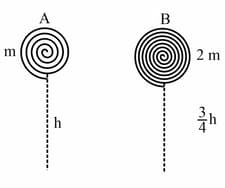MEDIUM
Earn 100
What is potential energy? An ideal spring having spring constant is compressed by distance. Derive the formula of acquired potential energy of the spring.
Important Questions on Work and Energy
MEDIUM
MEDIUM
MEDIUM
EASY
HARD
EASY
EASY
EASY
HARD
A spring of spring constant is compressed by , then determine the potential energy stored in spring.
EASY
EASY
MEDIUM
Ratio of potential energies of body A and body B will be

MEDIUM

